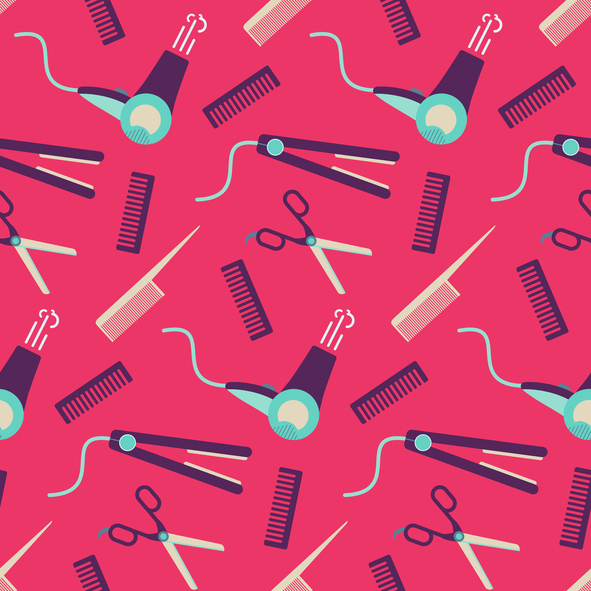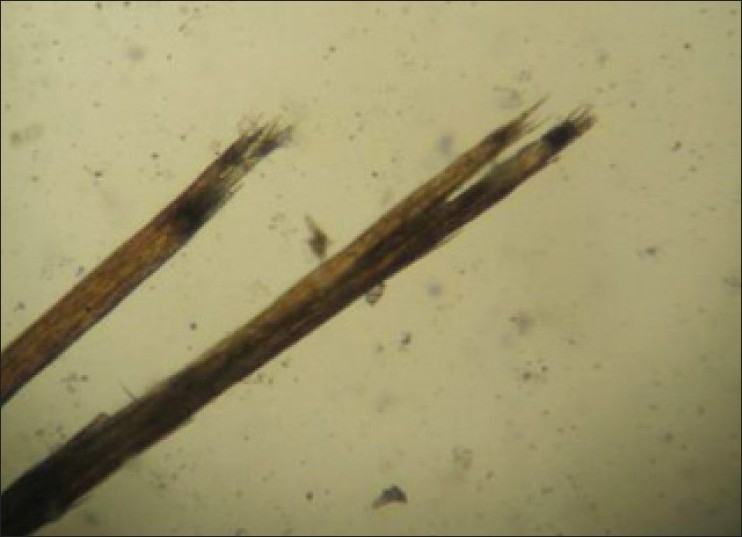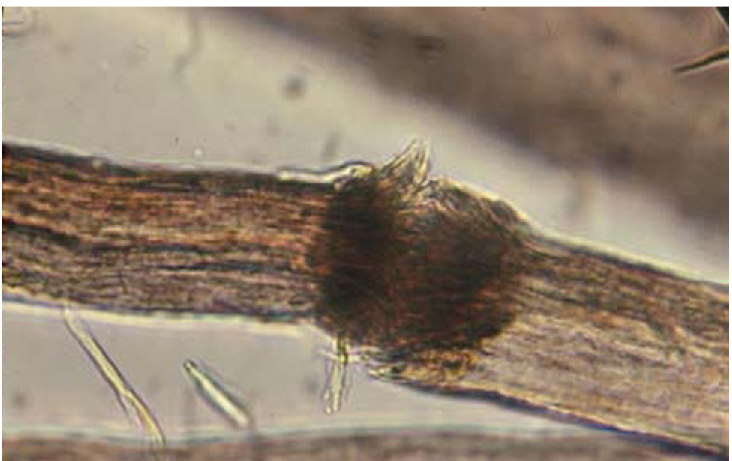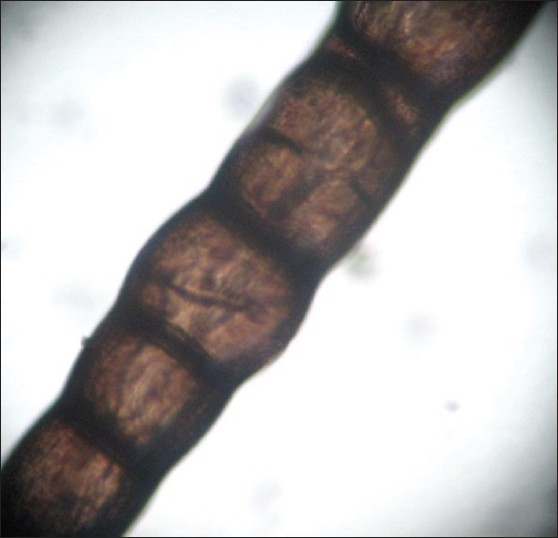

By Toni Woodard
March 15, 2018

Introduction
Thermal styling is a very common practice among women due to the many benefits that it provides. For example, it provides the hair with a sleek finish and also makes it more manageable. However, the use of heat on hair can come with the heavy price of damage to the interior and exterior components of the fiber. Many women with textured hair know that if heat is used on their hair, there is a possibility that when the hair is washed again some of the hair may not revert completely back to its original curl pattern. The curls may actually be looser with stray fibers becoming quite unruly as result of the heat damage. Even more serious, there are other common conditions that can afflict hair due to thermal exposure, especially if heating appliances are used excessively or improperly.
Three conditions that can result from excessive thermal exposure are trichoptilosis, acquired trichorrhexis nodosa, and bubble hair. That brings us to question: What exactly are these hair shaft deficiencies and what impact do they have in grooming practices involving heat? Trichoptilosis, seen in Figure 1, is a hair shaft abnormality due to physical damage to the fiber that is observed by fractures that run along the length of the hair.1 In this condition, cuticle cells are absent and the entire fiber is split into two more fragments at tip end of the fiber. The common name for this condition is split ends.

Figure 1: Light micrograph image of split ends observed in trichoptilosis. This micrograph originally appeared in A.S. Savitha et al., Bubble hair and other acquired hair shaft anomalies due to hot ironing on wet hair, Int. J. Trichology, 3, 118-120 (2011). Reprinted under the terms of the Creative Commons Attribution-Noncommercial-Share Alike 3.0 Unported.
Trichorrhexis nodosa, on the other hand, is an abnormality that is the result of repeated physical trauma that causes hair to be easily broken with nodes that can be seen on the hair shaft under the microscope.2 The hair is spread out and has the appearance of paintbrushes with the brush ends facing each other (Figure 2).2-4 In addition, the cuticle cells are diminished or missing along the hair shaft, leaving the cortical cells without protection.4 One of the things to note with trichorrhexis nodosa is that it can be congenital as well as acquired. For the purposes of this paper, we focus on the acquired form. The acquired form of this disease is the result of repeated practices to the hair that cause trauma, such as combing, brushing, and thermal treatment.4
In fact, there are two acquired forms of trichorrhexis nodosa, one being proximal (closer to the scalp) and the other distal (further away from the scalp).3,5 In the proximal case, it is more apparent in curly hair that has undergone chemical straightening treatments, which make the fibers very brittle.3,5 In the distal case, the condition is the result of mechanical manipulation or weathering, which causes the hair to look dull and begin to split, leaving strands that are not even.3,5 This weathering leads to advanced deterioration of the hair shaft.1,6

Figure 2: Brush-like appearance (node) typical of trichorrhexis nodosa. Reprinted from Journal of the American Academy of Dermatology, Vol. 59, Issue 1, A.S. Cheng and S.J. Bayliss, The genetics of hair shaft disorders, pp. 1-22, Copyright (2008), with permission from Elsevier.
The last abnormality discussed here is bubble hair. Bubble hair (Figure 3) is basically a hair shaft deficiency that has the appearance of little clusters of bubbles within the hair shaft.7 Particularly when the hair is wet, applying heat can cause water within the fiber structure to convert into steam. As a result, the water vapor attempts to escape causing the hair fiber to expand, ultimately giving it a sponge-like look.7

Figure 3: Light micrograph illustrating clustered bubbles observed in bubble hair. This micrograph originally appeared in A.S. Savitha et al., Bubble hair and other acquired hair shaft anomalies due to hot ironing on wet hair, Int. J. Trichology, 3, 118-120 (2011). Reprinted under the terms of the Creative Commons Attribution-Noncommercial-Share Alike 3.0 Unported.
These three hair shaft deficiencies are just a few of the conditions that result due to thermal treatment and repeated trauma. If heat styling is carried out improperly, or in excess, the described hair shaft deficiencies may make the hair brittle causing it to be susceptible to breakage and a dry appearance.
Heat Appliances and How They Work
There are a variety of different heat appliances on the market that consist of hair dryers, flat irons, curling irons, and hot combs. So, what exactly does heat do to the hair through these various thermal styling tools? Simply put, the heat breaks the hydrogen bonds and reforms them.8-11 The bonds being reformed are able to temporarily take on the new shape imparted by the specific appliance.8 More than likely, the changes in hydrogen bonding occur in the amorphous matrix region of the cortical cells of hair. The matrix provides support for the crystalline-phase intermediate filaments in hair. In addition, there might be some changes in electrostatic and disulfide bonds, although this topic has not been comprehensively approached in the literature.
Mode of Action of Heat Appliances in Causing Damage at High Temperatures
There are a variety of different temperatures that the heat appliances can be set at to cause the onset of hair shaft deficiencies. For example, treating at temperatures above 175 °C and leaving the heat source on the hair for up to five minutes can cause severe damage to the hair fiber.8 If the hair is not fully dry, the damage can be more immediate.8 Specifically, with the condition of bubble hair, it can occur with wet hair that is introduced to a temperature of 125 °C with hair dryer usage.12 Even at lower temperatures and shorter heat exposure times, damage can still occur. For example, Lee and coworkers optimized conditions for five samples of hair by introducing them to different heat conditions by use of a hair dryer.13 The conditions where untreated, air-dried, heat treatment at 47 °C for 60 s, heat treatment at 61 °C for 20 s, and heat treatment at 95 °C for 15 s. For the heat-treated samples, the dryer was held at distances of 15 cm, 10 cm, and 5 cm, respectively. Scanning electron microscopy showed that the untreated group and air-dried group had no evident cuticle damage. For the heat treated groups, there were exposed cracks in the cuticle with the 95 °C group exhibiting holes. When transmission electron microscopy was used, the untreated, air-dried, 41 °C, and 61 °C groups had no significant change in terms of damage. In the 95 °C group, however, the cuticles were “punched out.”10,13 Thermal exposure of hair to blow dryers at high temperatures may also cause the destruction and disappearance of the medulla in hair.14
Straightening and curling the hair at high temperatures can also be damaging. For example, hot combing is a technique that was introduced by Madame C.J. Walker.15 The hair goes through the process of being cleansed and conditioned and then a barrier aid, such as pressing oil, is applied to the hair.15,16 Then, a metal comb is heated on a stove and passed through dry hair in small sections.15-18 The straightening effect is only supposed to be temporary with more complete reversion.17,19 Temperatures can range from 65 °C to 260 °C for hot combs, and it is very easy to overheat the hair ultimately causing breakage of the fiber.16 Flat irons, which basically clamp the hair between two plates are sometimes viewed as safer to use, especially when the metal plates are coated with ceramic. The notion is that heat transfer is more evenly distributed, because of the ceramic coating.8 Flat irons have various temperature settings with higher settings typically reaching above 200 °C. The tolerance for heat is different for each hair type and sometimes it is not known that excessively using heat has caused damage until the hair starts to break.8,19,20 Often, when consumers see split ends or stray fibers, it is tempting for them to try to fix the problem by adding more heat.8
Curling irons can also reach high temperatures, making them another threat for sustained damage to the hair fiber.21-24 One study looked at curling iron temperatures ranging from 110 °C to 120 °C.20 This study examined the use of curling irons, following the manufacturer’s instructions, as well as deviating from those instructions. One of the claims states that if the instrument is used according to the guidelines (meaning that the hair is fully dry, the curling time is kept brief, and using normal tension), then there should be no damage imposed on the hair.20 The investigators of this study found that by following the guidelines there was very little damage to the hair fiber, especially if exposed to the curling iron in the dry state. If the curling time was extended to 10 min with tension increase, there was disintegration, as well as radial cracking. On wet hair, which is not recommended, the brief curling times and wetting showed less damage to the cuticle, which turned out to be comparable to the dry hair fiber. However, when the curling time was extended, there was distortion to the cuticle due to the rapid expansion of moisture, which in reality is steam trapped in the hair fiber; and as water vapor trys to escape, it causes bulges and ripples to form along the edges of the cuticle cells.
Treatments or Prevention of Hair Shaft Deficiencies
So the question remains: Is there any way to treat or prevent hair shaft abnormalities? The answer to this question is yes. Prevention of damage to the hair shaft may include limiting how often hair is exposed to heat; for example, using heat appliances once a week rather than every day.16,18 If any noticeable damage does occur, then application of heat should be stopped. Recovery of the hair may require utilizing moisturizing shampoos as well as conditioners.5,16,18 It may also be necessary to resist using chemicals as well and cutting off any damaged hair.7 Also, when heat treating the hair, it is important to make sure some sort of heat protectant is used. The main thing is to consider using products that contain certain polymers (e.g., VP/acrylate/lauryl methacrylate copolymer and polyquaternium-55) that can provide some protection for the hair fiber, which allows for a reduction in breakage to the hair.19 Oftentimes, a polymer coating on the fiber can serve as a sacrificial layer, thereby preventing direct contact with the thermal styling device and, possibly, providing a multilayer heat barrier due to multiple fibers in the hair fiber assembly.22
Conclusions
In conclusion, heat does not have to be eliminated from the styling regimen. It is the excess use of heat that is most worrisome due to the various hair conditions that may result. Proper guidelines include making sure the hair is dry and well protected prior to thermal exposure, and to use a low or medium heat setting. Most hair types, particularly curly hair, may benefit from applying thermal devices no more than once a week.8 Awareness is key, therefore, heat styling in moderation and making sure heat styling appliances do not exceed temperatures that can lead to hair shaft deficiencies is important for healthy hair. Since heat tolerance varies based on a variety of racial and genetic factors, learning how much heat the hair can handle is vital to good hair grooming practices.
References
1. M.V. Quaresma, M.A. Martinez Velasco, and A. Tosti, Hair breakage in patients of African descent: role of dermoscopy, Skin Appendage Disord., 1(2), 99-104 (2015).
2. A.M. Martin and P. Sugathan, Localised acquired trichorrhexis nodosa of the scalp hair induced by a specific comb and combing habit—A report of three cases, Int. J. Trichology, 3, 34-47 (2011).
3. A.S. Cheng and S.J. Bayliss, The genetics of hair shaft disorders, J. Am. Acad. Dermatol., 59, 1-22 (2008).
4. C.N. Lawson, J. Hollinger, S. Sethi, I. Rodney, R. Sarkar, N. Dlova and V.D. Callender, Updates in the understanding and treatments of skin and hair disorders in women of color, Int. J. Womens Dermatol., 3(Suppl 1), S21-S37 (2017).
5. E.B. Hawryluk and J.C. English, Female adolescent hair disorders, J. Pediatr. Adolesc. Gynec., 22, 271-281 (2009).
6. M.F. Gavazzoni Dias, Hair cosmetics: an overview, Int. J. Trichology, 7, 2-15 (2015).
7. A.S. Savitha, S. Sacchidanand, and T.N. Revathy, Bubble hair and other acquired hair shaft anomalies due to hot ironing on wet hair, Int. J. Trichology, 3, 118-120 (2011).
8. P. Mirmirani, Ceramic flat irons: improper use leading to acquired trichorrhexis nodosa, J. Am. Acad. Dermatol., 62, 145-147 (2010).
9. M. Feughelman, The change in stress on wetting and drying wool fibers, Text. Res. J., 29, 967–970 (1959).
10. M. Feughelman, Mechanical Properties and Structure of Alpha-Keratin Fibres, University of New South Wales Press: Sydney, Australia, 1997.
11. F.J. Wortmann, M. Stapels, L. Chandra, Humidity-dependent bending recovery and relaxation of human hair, J. Appl. Polym. Sci., 113, 3336–3344 (2009).
12. L.N. Albers, A. Maley, and J. MacKelfresh, Blowing bubbles: dermoscopy of bubble hair, Int. J. Trichology, 9, 122-123 (2017).
13. Y. Lee, Y.D. Kim, H.J. Hyun, L.Q. Pi, X. Jin, and W.S. Lee, Hair shaft damage from heat and drying time of hair dryer, Ann. Dermatol., 23, 455-462 (2011).
14. A.C. Noquiera, C. Scanavez, C. Carnelos, A. Gaspari, and I.S. Joekes, Hair color changes caused by dyeing and thermal treatments, J. Cosmet. Sci., 55, 437-447 (2004).
15. C. Bolduc and J. Shapiro, Hair care products: waving, straightening, conditioning, and coloring, Clin. Dermatol., 19, 431-436 (2001).
16. A.J. McMichael, Hair breakage in normal and weathered hair: focus on the Black patient, J. Invest. Dermatol. Symp. Proc., 12, 6-9 (2007).
17. M. Wong, G. Wis-Surel, and J. Epps, Mechanism of hair straightening, J. Soc. Cosmet., 45, 347-352 (1994).
18. A. Vij and W.F. Bergfeld, Trichodystrophies: a hair-raising differential diagnosis, Clin. Dermatol., 33, 613-621 (2015).
19. Y. Zhou, R. Rigoletto, D. Koelmel, G. Zhang, T.W. Gillece, L. Foltis, D.J. Moore, X. Qu, and C. Sun, The effect of various cosmetic pretreatments on protecting hair from thermal damage by hot flat ironing, J. Cosmet. Sci., 62, 265-282 (2011).
20. S.B. Ruetsch and Y.K. Kamath, Effects of thermal treatments with a curling iron on hair fiber, J. Cosmet. Sci., 55, 13-27 (2004).
21. R. McMullen and J. Jachowicz, Thermal degradation of hair. I. Effect of curling irons, J. Cosmet. Sci., 49, 223-244 (1998).
22. R. McMullen and J. Jachowicz, Thermal degradation of hair. II. Effect of selected polymers and surfactants, J. Cosmet. Sci., 49, 245-256 (1998).
23. E. Sayahi, T. Harizi, S. Msahli, and F. Sakli, Effects of treatments with curling iron on human hair fibers, Int. J. Recent Scientific Res., 7, 8736-8740 (2016).
24. P. Christian, N. Winsey, M. Whatmough, and P.A. Cornwell, The effects of water on heat-styling damage, J. Cosmet. Sci., 62, 15-27 (2011).